

Is it okay for clear quartz to have VERY TINY “air bubbles”? : Crystals. Why sound sounds funny underwater - Swim Guide. Bruce Thorson, Swim Guide Contributor May 16, 2016 Ever notice how sound is different underwater?

Whether you’re swimming, snorkelling, or scuba diving, as soon as your ears get below the waves everything sounds strange. You can’t tell what direction sound is coming from, or how far away it is. Scientists Have Finally Discovered Massless Particles, And They Could Revolutionise Electronics. After 85 years of searching, researchers have confirmed the existence of a massless particle called the Weyl fermion for the first time ever.

With the unique ability to behave as both matter and anti-matter inside a crystal, this strange particle can create electrons that have no mass. The discovery is huge, not just because we finally have proof that these elusive particles exist, but because it paves the way for far more efficient electronics, and new types of quantum computing. "Weyl fermions could be used to solve the traffic jams that you get with electrons in electronics - they can move in a much more efficient, ordered way than electrons," lead researcher and physicist M. Zahid Hasan from Princeton University in the US told Anthony Cuthbertson over at IBTimes. Cosmologists Prove Negative Mass Can Exist In Our Universe. Negative mass is the hypothetical idea that matter can exist with mass of the opposite sign to the ordinary stuff.
Instead of 2 kg, a lump of negative mass would be -2 kg. Nobody knows whether negative mass can exist but there have nevertheless been plenty of analyses to determine its properties. In particular, physicists have investigated whether negative mass would violate various laws of the universe, such as the conservation of energy or momentum and therefore cannot exist. These analyses suggest that although the interaction of positive and negative mass produces counterintuitive behaviour, it does not violate these conservation laws. These frogs walk instead of hop, video reveals. Frogs and toads jump, swim, climb, and even glide.
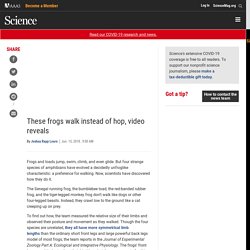
But four strange species of amphibians have evolved a decidedly unfroglike characteristic: a preference for walking. Now, scientists have discovered how they do it. The Senegal running frog, the bumblebee toad, the red-banded rubber frog, and the tiger-legged monkey frog don’t walk like dogs or other four-legged beasts. Instead, they crawl low to the ground like a cat creeping up on prey. To find out how, the team measured the relative size of their limbs and observed their posture and movement as they walked. Umami: why the fifth taste is so important. I am often flabbergasted when I think about how humans came to develop such complex culinary skills.

Granted, 1.8m years have passed since our ancestor, homo erectus, began to cook. But still, leavened bread! That was one hell of a happy accident. Our predilection for umami – the only recently recognised (by western scientists) "fifth taste", after salt, sweet, sour and bitter - is a fascinating piece in the jigsaw of our gastronomic evolution. Since studies confirmed just a few years ago that our mouths contain taste receptors for this moreish savoury taste (the other four "basic tastes" had been widely accepted for, ooh, a few thousand years), so much in the history of recipes suddenly makes sense. Newtonian mechanics - Why would a spinning space station create a centrifugal force on an astronaut rather than simply spinning around him/her? This is a really nuanced issue, but it is not the spinning space station that "causes" the centrifugal force, but the spinning frame of reference.
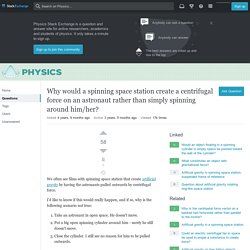
Cosmologists Prove Negative Mass Can Exist In Our Universe. Exoplanets could avoid 'tidal locking' if they have atmospheres. How Mars’s Magnetic Field Let Its Atmosphere Slip Away. Four and a half billion years ago, Mars boasted a thick atmosphere and abundant surface water—conditions that could have hosted life.
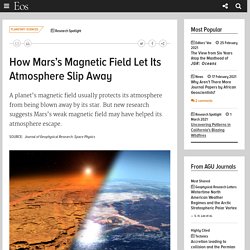
But today, only wisps of that atmosphere are left, clinging thinly to the planet. How did so much Martian air slip into space? One major factor is thought to be the loss of the planet’s magnetic dynamo—the engine in its liquid core that powered its global magnetic field, which mysteriously shut down around 4 billion years ago. Left behind was only a feeble remnant of that field, emanating from the planet’s weakly magnetized crust. Conventional wisdom holds that a planetary magnetic field acts as a shield, protecting the atmosphere from being blown into space by the Sun’s solar wind and radiation (which would have been even stronger when the Sun was younger).
Knowablemagazine. Stellar Flares May Not Condemn a Planet's Habitability. Red dwarf stars are the most common kind of star in our neighbourhood, and probably in the Milky Way.

Because of that, many of the Earth-like and potentially life-supporting exoplanets we’ve detected are in orbit around red dwarfs. The problem is that red dwarfs can exhibit intense flaring behaviour, much more energetic than our relatively placid Sun. So what does that mean for the potential of those exoplanets to actually support life? Most life on Earth, and likely on other worlds, relies on stellar energy to survive. The Sun has been the engine for life on Earth since the first cells reproduced. Sometimes it emits extremely energetic flares.
But in terms of flaring activity, the Sun is relatively weak compared to some other stars. Potentially Habitable, Tidally-Locked Exoplanets May be Very Common, say New Study. Studies of low-mass, ultra-cool and ultra-dim red dwarf stars have turned up a wealth of extra-solar planets lately.
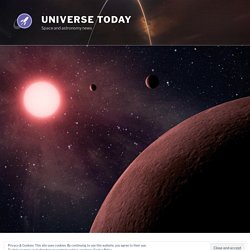
These include the discoveries of a rocky planet orbiting the closest star to the Solar System (Proxima b) and a seven-planet system just 40 light years away (TRAPPIST-1). In the past few years, astronomers have also detected candidates orbiting the stars Gliese 581, Innes Star, Kepler 42, Gliese 832, Gliese 667, Gliese 3293, and others. The majority of these planets have been terrestrial (i.e. rocky) in nature, and many were found to orbit within their star’s habitable zone (aka. Full atmosphere-ocean model of a rotationally locked exoplanet. The most common stars in our galaxy are dwarfs—smaller, reddish stars that emit far less light than our Sun.
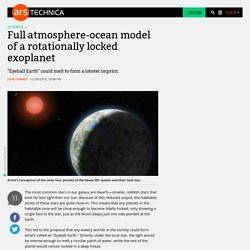
Because of this reduced output, the habitable zones of these stars are quite close-in. This means that any planets in the habitable zone will be close enough to become tidally locked, only showing a single face to the star, just as the Moon keeps just one side pointed at the Earth. This led to the proposal that any watery worlds in the vicinity could form what's called an "Eyeball Earth. " Superhabitable planet. Hypothetical type of planet that may be better-suited for life than Earth is Artist's impression of one possible appearance of a superhabitable planet.
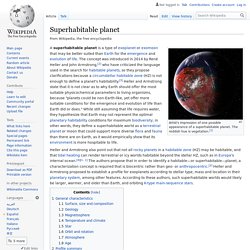
The reddish hue is vegetation.[1] How Tidal Heating May Aid the Formation of Magnetic Fields Around Exoplanets. Earth-like exoplanets may have magnetic fields capable of protecting life – Exoplanet Exploration: Planets Beyond our Solar System. From University of Washington Earth-like planets orbiting close to small stars probably have magnetic fields that protect them from stellar radiation and help maintain surface conditions that could be conducive to life, according to research from astronomers at the University of Washington. A planet’s magnetic field emanates from its core and is thought to deflect the charged particles of the stellar wind, protecting the atmosphere from being lost to space. Magnetic fields, born from the cooling of a planet’s interior, could also protect life on the surface from harmful radiation as the Earth’s magnetic field protects us.
Low-mass stars are among the most common in the universe. Planets orbiting near low-mass stars are easier for astronomers to target for study because when they transit, or pass in front of their host star, they block a larger fraction of the light than if they transited a more massive star. Alien plants may come in all colours but blue : Nature News. For plants on alien worlds, it isn't easy being green. By Jeff Hecht The greenery on other planets may not be green. Astrobiologists say plants on Earth-sized planets orbiting stars somewhat brighter than the Sun may look yellow or orange, while those on planets orbiting stars much fainter than the Sun might look black. Vegetation colour matters to astrobiologists because they want to know what to look for as a sign of life on planets outside the solar system.
Terrestrial photosynthesis depends mostly on red light, the most abundant wavelength reaching the Earth’s surface, and blue light, the most energetic. Plants also absorb green light, but not as strongly, so leaves look green to the eye. Extraterrestrial plants will look different because they have evolved their own pigments based on the colours of light reaching their surfaces, says Nancy Kiang of the NASA Goddard Institute for Space Sciences in New York, US. Www.universetoday. Images Website for this image Red Suns and Black Trees: Shedding a New Light on Alien Plants ... universetoday.com Similar images Images may be subject to copyright. How-trees-changed-world. Images Website for this image Science and Evolution: How trees changed the world scienceandevolution.blogspot.com Similar images Images may be subject to copyright. Full atmosphere-ocean model of a rotationally locked exoplanet. We don't really understand habitable zones. In the hunt for life outside the Earth, astronomers are keen to spot exoplanets in the "habitable zone," — the region around a star where liquid water can exist on a planet.
Nitrogen gas may point to alien life on exoplanets. WASHINGTON: Observations of nitrogen in Earth's atmosphere by a NASA spacecraft 17 million miles away are giving astronomers fresh clues to how the gas may help in the search for life on exoplanets. 30 Birds When They're Babies Versus All Grown Up. The Science of CAR-T Cell Therapy. CAR-T cell therapy: The living drug1 CAR-T cell therapy is a targeted, personalised therapy that contains patients’ autologous T cells reengineered to fight cancer. This living drug continues to exist in the body and combat cancer long after its infusion.
Sharpest ever view of the Andromeda Galaxy. What is a person’s ‘legal sex?’ In law, as in biology, the components of sex don’t always line up. Could An Incompleteness In Quantum Mechanics Lead To Our Next Scientific Revolution? Brookhaven National Laboratory. Liquor before beer? You will still feel terrible, new study says. Hero Images | Getty Images. What is a tensor? String Theory Explained: A Brief Overview for Starters. Along with sentience, dexterous hand, sharp brain, what comes with a human body is an inquisitive and overly curious mind which keeps figuring out the ideas behind everything around it.
Why do objects with mass attract each other? NASA claims initial motion is key to ensuring a real-life WARP ENGINE is in drive not reverse Q & A: Massless Particles Traveling at the Speed of Light. Hi Matt, In order to answer your first question, we have to introduce the relationship between energy, mass, and momentum in special relativity. Are atoms expanding as the Universe expands? Asked by: Tony Karger, Norfolk The expansion of the Universe only significantly affects space and time on scales bigger even than entire clusters of galaxies. The Unknown Universe – 10 questions still confounding cosmologists. Space travel - What could possibly power an Alcubierre drive? Physicists Say They've Created a Device That Generates 'Negative Mass'
Why do objects with mass attract each other? What are neutron stars made of? Are octopuses smart? "Our universe would be destroyed": Inside the science of "Interstellar" » Might gravity have mass? Brilliant GIF shows how Humans, Birds and Insects Breathe. Www.howtogeek. Why Can't Quantum Mechanics Explain Gravity? Why Quantize Gravity? Mars Colony: A City on Mars Could Descend Into Cabin Fever and Nationalism. Why Can't Quantum Mechanics Explain Gravity? Plot explanation - How did the watch do what it did? - Movies & TV Stack Exchange. Shaking the dark matter paradigm.
Inhaled Tree Nut Allergen. Can gravity exist without matter? What Is Angular Momentum, Anyway? Former NASA scientist says they found life on Mars in the 1970s - CNN. Does Dark Energy Exist? Einstein's General Relativity Could Rid Us of the Need for Universe's Most Mysterious Force. University of Illinois at Urbana-Champaign. The United States at the LHC. Hubble bubble (astronomy) The downside of warp drives: Annihilating whole star systems when you arrive. How to Get to the Fourth Dimension. Permanent Magnet. Difference Between Magnetism and Electromagnetism. Do galaxies that are receding from us faster than the speed of light disappear from our observations? (Intermediate) - Curious About Astronomy? Ask an Astronomer.
B-cells. How Do We Terraform Venus? Google claims it reached “quantum supremacy.” What the heck does that mean? - Vox. Miguel Alcubierre’s Warp Antrieb. Habitable planets around red dwarf stars might not get enough photons to support plant life. NASA engineer's 'helical engine' may violate the laws of physics.
A slightly serious habitability ranking of TRAPPIST-1's planets. Which Habitable Zones are the Best to Actually Search for Life? Davis STAIF conference 2. Miguel Alcubierre’s Warp Antrieb. Word for increasing acceleration. Calculate Your Age on other Planets. Here's What Earth Might Look Like In 100 Years – If We're Lucky. Hawking radiation. NPR Choice page. Torus – Exo News. Harold White warp drive experiment. IXS Enterprise. How close to a viable warp drive are we? How close to a viable warp drive are we? NASA is Working on a Real-Life Star Trek Warp Drive.
Icists create 'negative mass' Real World Examples of Quadratic Equations. Ask Ethan: Why Must Time Be A Dimension? Finally: Missing Link Between Vitamin D and Prostate Cancer Discovered. What is the difference between quantum physics and particle physics? IQ, explained in 9 charts. What does it mean for string theory that the LHC has not seen supersymmetric particles? How the LHC may spell the end of particle physics.
Why some scientists say physics has gone off the rails. Why Supersymmetry May Be The Greatest Failed Prediction In Particle Physics History. Exclusive: This Wild Paper Suggests Gravity Is Just a Product of Quantum Mechanics.